
16 White Kitchen With Dark Floors That Feel Dramatic and Refined
White kitchens paired with dark floors embody dramatic visual contrast and refined balance through the juxtaposition of bright cabinetry and grounding hardwood. The white surfaces amplify ambient light and expand spatial perception, while deep-toned flooring anchors the design with visual heft and durability. Contrasting textures, such as rustic backsplashes and polished countertops, further enrich the composition. Thoughtful lighting and strategic storage guarantee functional clarity. The following ideas illustrate how accent choices and finishes can amplify this sophisticated effect.
Key Takeaways
- Contrasting white cabinetry with dark hardwood floors creates striking visual drama and a refined, timeless aesthetic.
- Textured backsplashes and metallic accents add depth, tactile interest, and sophisticated complexity to the kitchen design.
- Strategic lighting, including under-cabinet and pendant fixtures, enhances brightness and highlights the interplay of light and dark surfaces.
- Open floor plans with large islands and floor-to-ceiling cabinetry maximize storage, function, and seamless visual flow.
- Sustainable materials, layered textures, and personalized accents ensure the space feels both elegant and inviting.
Striking Contrast: The Allure of White Cabinets and Dark Floors
By juxtaposing crisp white cabinetry with rich, dark flooring, kitchen design achieves a high-impact visual contrast that underscores both spatial clarity and modern sophistication. The strategic use of white cabinets amplifies ambient light, reflecting it across the space and making the kitchen appear expansive and inviting. In contrast, dark hardwood floors ground the composition, delivering both visual weight and a timeless sense of durability. This interplay of light and dark elements adheres to key design principles—balance, unity, and contrast—while also facilitating versatility in decorative schemes. Dark hardwood floors provide practical advantages, effectively concealing wear in high-traffic zones yet maintaining aesthetic elegance. The result is a refined canvas where textures and accent colors can be thoughtfully layered without disrupting the overall cohesive visual narrative. Additionally, the use of light greige tones can foster a calming and inviting environment, enhancing the overall mood and atmosphere in the kitchen.
Cozy Farmhouse Vibes With Rustic Backsplash Ideas

Building upon the dynamic interplay of white cabinetry and dark wood flooring, the integration of a rustic backsplash introduces an additional layer of tactile richness and visual complexity to the farmhouse kitchen aesthetic.
Multi-toned tiles in gray, white, and off-white yield a nuanced chromatic shift that anchors the space, while textured materials—such as stone or handmade tile—convey authentic craftsmanship and depth.
The juxtaposition of a rustic backsplash against white cabinetry creates deliberate contrast, enhancing visual interest without disrupting cohesion.
Earthy tones within the backsplash visually harmonize with dark wood flooring, reinforcing the kitchen’s rustic charm and refined elegance.
Strategic incorporation of organic elements, like small succulents, within the backsplash design further amplifies warmth, inviting a sense of coziness synonymous with the farmhouse ethos.
Additionally, incorporating reclaimed wood into the design can further enhance the kitchen’s rustic charm, adding unique grain patterns and warmth that embody rustic authenticity.
Modern Minimalism: Clean Lines and Open Spaces
In white kitchens, the juxtaposition of crisp white cabinetry against dark floors exemplifies this principle. The interplay of light and dark amplifies spatial perception, drawing the eye along clean lines and accentuating geometric forms. Open spaces and uncluttered surfaces are prioritized, optimizing both utility and refined aesthetics. Modern minimalism in kitchen design employs the following strategies:
- Streamlined cabinetry: Flat-panel doors and hardware-free fronts create uninterrupted planes, reinforcing a minimalist ethos.
- Open shelving: Selective display and concealed storage maintain organizational clarity and visual spaciousness.
- Enhanced natural light: Abundant illumination enhances the brilliance of white finishes, while dark floors ground the composition.
- Functional zoning: Strategic layout guarantees workflow efficiency without sacrificing the integrity of open space.
To further enhance a minimalist kitchen, natural and strategically placed lighting can improve both functionality and aesthetics, creating a balanced environment.
Sophisticated Traditional Kitchens With Cherry Wood Accents
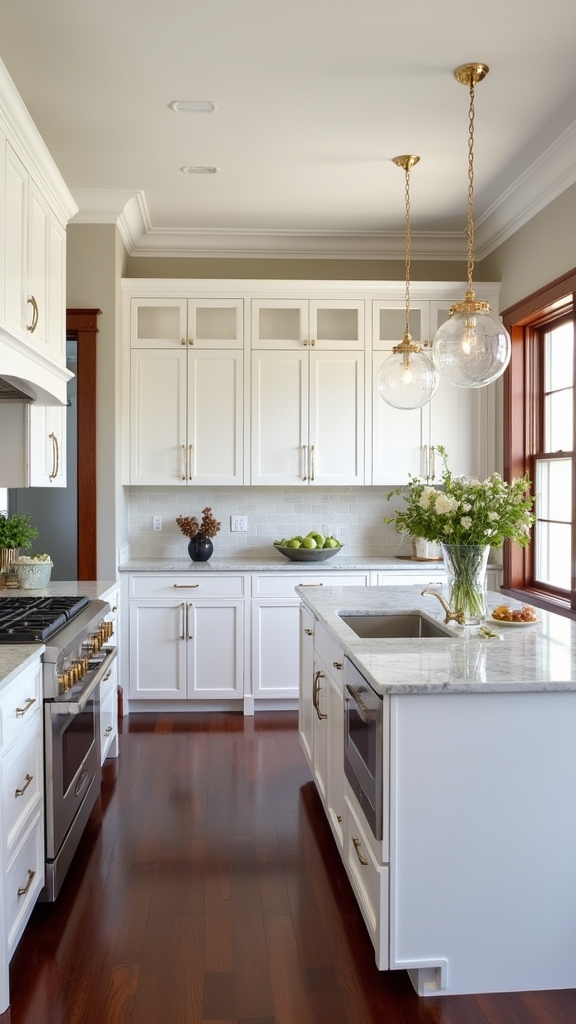
While modern minimalism capitalizes on stark contrast and clean geometry, sophisticated traditional kitchens introduce a nuanced interplay between timeless materials and refined detailing. Cherry wood accents, when juxtaposed with white cabinets, generate a spectrum of warm undertones that enhance the spatial composition. The inherent grain variation of cherry wood injects visual complexity, maintaining cohesion with the cabinetry’s crisp palette. When combined with dark wood floors, the effect is a dramatic yet harmonious environment, where each element is purposefully articulated. Design strategies such as cherry wood islands or decorative moldings underscore craftsmanship while reinforcing the kitchen’s functional layout. Reflective surfaces like high-gloss finishes create a visually striking and spacious effect, amplifying brightness and energy while offering functional benefits such as ease of cleaning. The table below summarizes key design elements:
| Element | Visual Effect |
|---|---|
| Cherry Wood Accents | Warmth, Rich Contrast |
| White Cabinets | Brightness, Clarity |
| Dark Wood Floors | Depth, Sophistication |
Timeless Design: White Cabinets Meet Dark Hardwood Elegance
The juxtaposition of crisp white cabinetry against dark hardwood flooring establishes a classic contrast that anchors the kitchen in enduring visual appeal. This synthesis of light and dark not only amplifies spatial luminosity but also introduces a layer of warmth that complements both contemporary and traditional design schemes. The result is a harmonious environment where modern sophistication is achieved without sacrificing timeless character. Greige cabinets seamlessly blend with various design styles, ensuring a timeless appeal that enhances the overall aesthetic of your kitchen.
Classic Contrast Endures
Visual contrast anchors the enduring appeal of white cabinets paired with dark hardwood floors, establishing a foundation for refined kitchen design. This juxtaposition leverages principles of balance and harmony, allowing each element to assert its visual identity while enhancing the spatial dynamics of the kitchen environment.
The interplay between the light-reflective surfaces of white cabinets and the visual depth of dark floors creates a compelling, timeless aesthetic.
- Spatial Perception: White cabinets amplify ambient light, visually expanding the kitchen and fostering a sense of openness.
- Depth and Warmth: Dark floors introduce warmth and visual grounding, providing a dramatic counterpoint to the cabinetry.
- Versatility: This classic palette adapts seamlessly to both traditional and contemporary design schemes.
- Practicality: Dark floors conceal wear, contributing to long-term durability and ease of maintenance.
Warmth Meets Modern Sophistication
Building on the enduring appeal of classic contrast, the pairing of white cabinets with dark hardwood floors exemplifies a synthesis of warmth and modern sophistication. This juxtaposition leverages design principles such as visual hierarchy and spatial balance. White cabinets optimize light reflectivity, promoting an open, luminous environment, while dark floors introduce grounding, tactile warmth. The interplay between these opposing values enhances both spatial perception and functional aesthetics. Adaptable across multiple design genres, this combination accommodates diverse countertop and backsplash materials without disrupting overall cohesion. The following table illustrates key design considerations:
| Design Element | Impact on Space |
|---|---|
| White Cabinets | Light Reflection |
| Dark Hardwood Floors | Depth & Warmth |
| Contrasting Palette | Visual Drama |
| Versatility | Material Integration |
| Modern Sophistication | Timeless Elegance |
Light and Space: Maximizing Brightness in Your Kitchen

Maximizing perceived brightness in a kitchen environment relies on the interplay of reflective surfaces, purposeful lighting distribution, and unobstructed fenestration. Glossy cabinetry finishes and polished countertops optimize light diffusion, while targeted fixtures such as pendant and under-cabinet lights accentuate both functional zones and spatial depth. Minimalist window treatments guarantee maximum daylight penetration, reinforcing the sense of openness within the contrasting palette of white cabinetry and dark flooring. Additionally, incorporating kitchen sink holders can improve organization, which contributes to a cleaner and more visually appealing kitchen space.
Reflective Surfaces Enhance Light
By incorporating reflective surfaces such as high-gloss cabinetry and polished countertops, a kitchen’s ambient light is amplified, creating a sense of expanded space.
In design, the interplay between reflective surfaces and white cabinets is instrumental in maximizing the perceived brightness of kitchens with dark floors. White cabinets act as light reflectors, counterbalancing the visual weight of dark wood flooring and contributing to a refined luminosity.
This strategic contrast emphasizes spatial openness and modernity.
- High-Gloss Finishes: Cabinetry and countertops with sheen surfaces intensify both natural and artificial light reflection.
- White Cabinetry: White cabinets enhance brightness, dispersing light uniformly across the kitchen.
- Light-Colored Backsplashes: Bright backsplashes harmonize with reflective surfaces, enhancing the overall illumination.
- Polished Countertops: Smooth, glossy countertops further bounce light, accentuating visual spaciousness and clarity.
Strategic Lighting Placement
While reflective surfaces play a pivotal role in amplifying illumination, the orchestration of lighting elements determines how effectively brightness and spatial perception are achieved in a white kitchen with dark floors. Strategic lighting placement—particularly under-cabinet fixtures and pendants over islands—directly addresses both task and ambient needs, ensuring white cabinets are visually prominent and dark floors remain balanced. Incorporating layered lighting, with ambient, task, and accent sources, accentuates contrast and architectural features. Utilizing natural light via expansive windows or skylights enhances spatial openness. Warm-toned bulbs soften the stark juxtaposition between cabinetry and flooring, promoting a cohesive and inviting atmosphere. Dimmable overhead fixtures further refine control, enabling adaptive brightness for varied moods and functions.
| Lighting Type | Design Benefit |
|---|---|
| Under-cabinet | Task clarity, highlights cabinetry |
| Pendant | Focal points, visual interest |
| Ambient | Even, overall illumination |
| Accent | Emphasizes design elements |
| Dimmable overhead | Adjustable brightness, mood control |
Minimalist Window Treatments
When seeking to optimize both illumination and spatial perception in a white kitchen with dark floors, minimalist window treatments function as a critical design element.
These treatments, such as sheer shades or roller blinds, emphasize a clean aesthetic, visually expanding the space while complementing white cabinets. The integration of light-colored or translucent materials amplifies natural light, enhancing the kitchen’s brightness and reinforcing a sense of airiness.
Streamlined, unembellished designs reinforce a calm, refined environment in harmony with dramatic dark flooring. For effective implementation, consider:
- Selecting sheer or light-filtering fabrics to maximize daylight.
- Utilizing simple, adjustable mechanisms like Venetian blinds for light control.
- Coordinating window treatment hues with the palette of white cabinets and dark floors.
- Prioritizing unobtrusive hardware to maintain seamless visual flow.
Dramatic Two-Tone Kitchen Island Inspirations
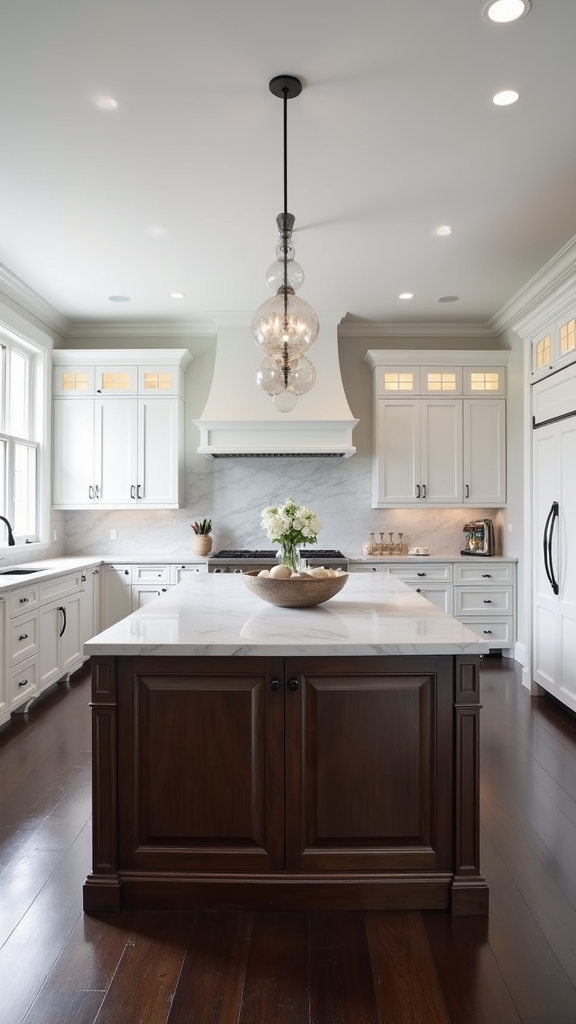
How does a kitchen achieve visual gravitas amid the interplay of light and dark elements? The answer often lies in the implementation of a two-tone kitchen island.
By pairing a dark base—such as deep navy or emerald green—with a lighter countertop in quartz or marble, designers establish a dramatic contrast that immediately draws the eye. This intentional juxtaposition serves as a striking focal point within white kitchens anchored by dark floors.
Texture differentiation, such as a shaker-style base paired with a smooth surface, further amplifies the island’s visual depth. To maintain design cohesion, hardware and fixtures—particularly in finishes like brass—are selected to harmonize with both color zones. The color psychology of green evokes calmness and sophistication, which can enhance the serene environment of a kitchen.
The result is a sophisticated centerpiece that advances both functionality and refined aesthetic balance.
Classic Hampton Style With Dark Floors

Classic Hampton style kitchens exemplify timeless design elements through the juxtaposition of crisp white cabinetry and deep-toned hardwood flooring, achieving both visual balance and enduring appeal.
The elegant color contrast enhances spatial definition, while reflective surfaces and natural materials contribute to layered texture and warmth.
Functional space planning, including generous islands and integrated storage, guarantees the kitchen remains both aesthetically refined and highly practical for everyday use.
Consider the addition of weathered wood floors for an extra touch of rustic charm and durability, seamlessly integrating with the classic Hampton style.
Timeless Design Elements
By integrating crisp white cabinetry with dark hardwood flooring, the Hampton style kitchen achieves a visually striking juxtaposition that underscores both elegance and functionality.
These foundational elements evoke a sense of timeless beauty, transforming the space into a classic kitchen that feels both enduring and inviting.
The design relies on sophisticated detailing and material coherence to guarantee lasting appeal.
Key timeless design elements include:
- Decorative Moldings: Crown and base moldings add architectural interest and visual refinement.
- Classic Hardware: Polished nickel or brushed brass hardware reinforces the kitchen’s enduring character.
- Natural Materials: Stone countertops and wooden accents provide textural depth and complement the dark flooring.
- Strategic Lighting: Layered pendant and under-cabinet lighting accentuate the interplay of light and shadow, enhancing spatial perception.
These components define a quintessential Hampton kitchen.
Elegant Color Contrast
Drama and balance define the visual language of a Hampton-style kitchen through the deliberate juxtaposition of white cabinetry against dark hardwood floors. This strategic color contrast amplifies spatial perception, with the white cabinets reflecting natural light, enhancing brightness, while the dark floors ground the space, providing depth and warmth. The resulting interplay between these elements produces a sophisticated, timeless backdrop adaptable to evolving design trends. Integrating organic textures, such as wood accents or stone countertops, further accentuates the bold differentiation between light and dark surfaces, reinforcing the classic Hampton aesthetic.
| Element | Visual Effect | Design Principle |
|---|---|---|
| White Cabinets | Reflects Light | Enhances Brightness |
| Dark Floors | Adds Depth | Grounds the Space |
| Natural Accents | Texture Contrast | Enriches Visual Balance |
Functional Space Planning
Beyond the striking interplay of color and texture, effective functional space planning underpins the enduring appeal of Hampton-style kitchens with dark floors. The juxtaposition of crisp white cabinetry with rich, dark flooring establishes a sophisticated foundation, but the success of these kitchens hinges on layout optimization and spatial efficiency.
Functional space planning not only maximizes usability but also preserves the visual harmony essential to the Hampton aesthetic. Key design principles include:
- Open layouts: Promote fluid circulation for effortless movement and social interaction.
- Large kitchen islands: Offer expansive prep areas, integrated seating, and discrete storage solutions.
- Floor-to-ceiling cabinetry: Provides abundant storage while maintaining an uncluttered, vertical visual line.
- Strategic lighting: Illuminates work zones and accentuates the dramatic contrast between white surfaces and dark floors.
Functional Beauty: Storage and Organization Tips

While the striking interplay of white cabinetry and dark flooring establishes a visually compelling kitchen, true functional beauty emerges through meticulous storage and organization strategies.
Efficient storage solutions, such as floor-to-ceiling kitchen cabinets, capitalize on verticality, reducing visual clutter and maintaining seamless lines. Islands equipped with integrated drawers offer both high-capacity storage and ergonomic access to frequently used items, preserving clear work surfaces.
Bespoke cabinetry, featuring pull-out shelves and corner carousels, maximizes underutilized spaces, aligning with principles of spatial optimization and workflow efficiency. Glass-fronted cabinets provide a dual function: organized display and decorative enhancement, amplifying the kitchen’s refined character.
Additional features, like hanging pot racks and magnetic knife strips, liberate drawer space while contributing to a cohesive, orderly aesthetic within the dramatic white-and-dark flooring scheme. Embracing the appliance garage trend can further enhance kitchen functionality by keeping countertops clutter-free and providing dedicated storage for appliances.
Mixing Materials: Natural Wood, Stone, and Metallic Touches
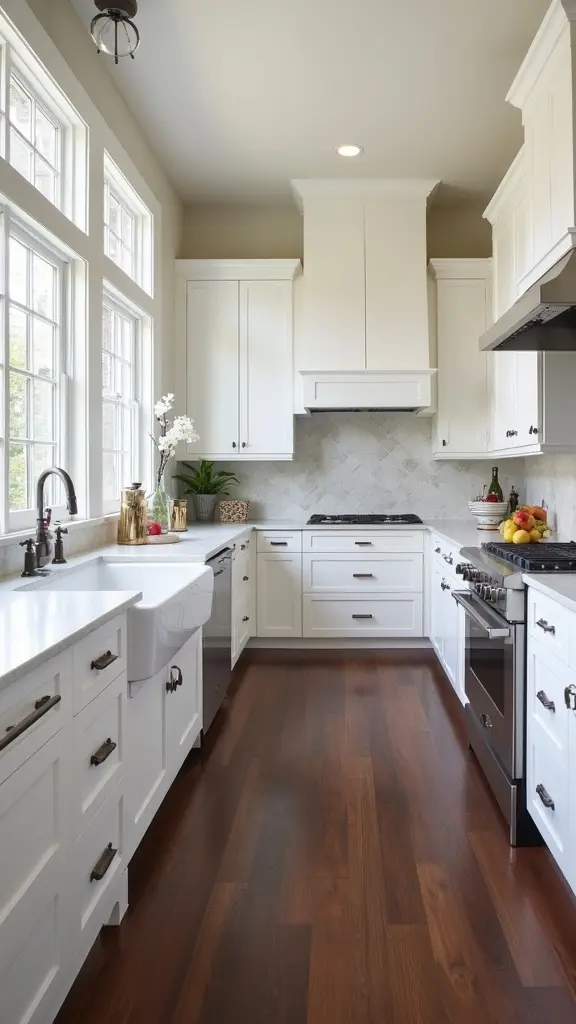
By integrating natural wood, stone, and metallic accents, a white kitchen with dark floors achieves a sophisticated interplay of texture and contrast rooted in contemporary design principles.
The juxtaposition of crisp white cabinetry against dark wood flooring amplifies visual drama, while the inclusion of natural wood elements—such as open shelving or butcher-block islands—introduces warmth and organic character.
Stone countertops, whether marble or granite, add both durability and a tactile surface that complements the surrounding finishes.
Metallic touches, like brass or chrome hardware, infuse a modern edge without overpowering the subtlety of wood and stone.
Incorporating chic cabinet hardware in brass or copper further enhances the elegance and personal flair of the kitchen.
For ideal cohesion, designers recommend:
- Balancing warm wood grains with cooler stone hues.
- Utilizing metallic touches for focal hardware.
- Selecting unified color palettes.
- Layering materials for dimensional depth.
Breathtaking Kitchen Layouts for Every Home

Ideal kitchen layouts in white-and-dark floor schemes prioritize functional zone planning, ensuring clear separation between preparation, cooking, and dining areas.
Maximizing storage efficiency is achieved through the integration of floor-to-ceiling cabinetry and concealed organizational systems, preserving a streamlined aesthetic.
Seamless flow design, often realized with open concepts and central islands, enhances spatial connectivity and visual balance within the environment.
Functional Kitchen Zone Planning
Through strategic functional kitchen zone planning, designers delineate clear areas for cooking, preparation, and cleaning, establishing a workflow that minimizes congestion and maximizes efficiency.
Functional zoning leverages technical kitchen features and spatial organization, with the work triangle—a concept linking the stove, sink, and refrigerator—serving as a cornerstone for ideal movement and accessibility.
Sufficient counter space between zones guarantees seamless changes, while multifunctional islands integrate prep space, seating, and storage, elevating both utility and aesthetics.
Thoughtful placement of appliances and targeted storage solutions within each designated zone result in a streamlined, adaptable kitchen suited to diverse culinary tasks.
- Defined cooking, prep, and cleaning zones for traffic flow
- Work triangle principle for ergonomic efficiency
- Counter space allocation to prevent overcrowding
- Multifunctional islands for expanded utility and visual interest
Maximizing Storage Efficiency
While balancing aesthetic appeal with functional demands, maximizing storage efficiency in white kitchens with dark floors relies on smart spatial allocation and tailored cabinetry solutions.
Floor-to-ceiling white cabinets exploit vertical real estate, reducing countertop clutter and establishing a seamless visual rhythm.
Kitchen islands with integrated drawers offer dual utility, enhancing storage while expanding meal preparation zones.
Custom cabinetry features—such as pull-out shelves and corner carousels—optimize hard-to-reach areas, ensuring every inch serves a purpose.
Open shelving, juxtaposed with closed cabinets, introduces opportunities for both display and accessible storage, contributing visual contrast against the dark flooring.
Strategic cabinetry and appliance placement within the kitchen layout further refines workflow, promoting ergonomic access and minimizing unnecessary movement, essential for achieving both order and sophistication in contemporary kitchen design.
Seamless Flow Design
By prioritizing unobstructed circulation and visual continuity, seamless flow design transforms white kitchens with dark floors into cohesive, functional environments.
This approach leverages the interplay of white cabinets against dark flooring to enhance spatial perception and dramatic contrast, while maintaining a unified aesthetic. The technical execution relies on thoughtful spatial planning and material consistency, ensuring both movement and sightlines remain uninterrupted across zones.
Key design principles include:
- Open Layouts: Eliminate barriers to facilitate smooth connections between kitchen, dining, and living spaces.
- Consistent Finishes: Extend color palettes and materials—such as white cabinetry and rich flooring—into adjoining areas for harmonious integration.
- Strategic Islands: Position islands or peninsulas to encourage workflow while serving as visual anchors.
- Integrated Lighting: Employ layered lighting solutions to highlight focal points and reinforce seamless flow design.
Versatile Decor: Neutral Palettes and Accent Colors

When selecting decor for white kitchens with dark floors, a neutral palette—incorporating grays, beiges, and whites—establishes a balanced visual foundation that accentuates the luminosity of white cabinetry and the depth of darker flooring.
Neutral palettes serve as a cohesive backdrop, reducing visual noise and highlighting architectural elements. To introduce vibrancy and individual character, accent colors can be strategically applied through textiles, artwork, or small appliances.
A neutral backdrop calms the space, while thoughtfully placed accents infuse personality and enliven the kitchen’s overall design.
This approach maintains design unity while allowing for dynamic visual interest. Natural materials, such as wood and stone, add tactile contrast and visual warmth, counterbalancing the crispness of white surfaces.
Metallic finishes in brass or chrome further enhance the aesthetic, providing a refined gleam. A thoughtfully coordinated backsplash unifies neutral palettes and accent colors, enhancing compositional harmony.
Creating Warmth: The Role of Lighting and Fixtures
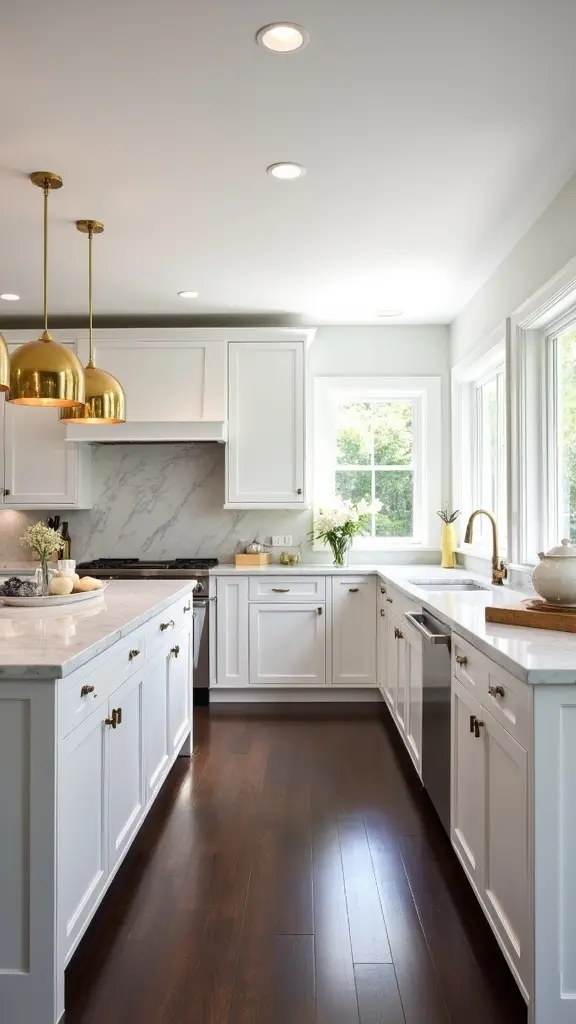
Although the interplay of white cabinetry and dark flooring establishes a striking visual framework, the integration of carefully selected lighting and fixtures is essential to infuse warmth and depth into the kitchen environment.
Strategic lighting design not only accentuates the contrast between surfaces but also enhances spatial perception and ambiance. Employing a layered lighting approach—combining ambient, task, and accent sources—enriches the dimensionality of the space.
Warm-toned fixtures, such as brass or copper, introduce tactile elegance and visual cohesion. Dimmer switches further refine the atmosphere, enabling nuanced control over luminance.
- Pendant and under-cabinet lighting amplify contrast and drama.
- Metallic fixtures inject warmth, reinforcing design unity.
- Layered illumination generates depth and highlights material interplay.
- Dimmer switches facilitate adaptable, mood-responsive lighting environments.
Easy Maintenance: Cleaning Tips for White and Dark Surfaces
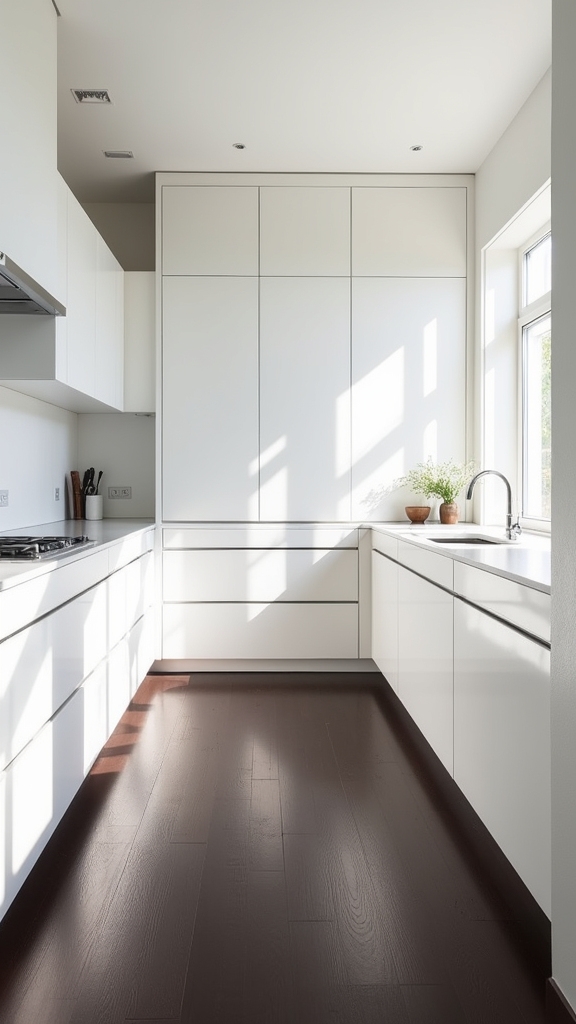
Beyond the impact of lighting and fixtures on ambiance, the continued allure of a white kitchen with dark floors relies on meticulous upkeep of both surfaces.
Achieving a consistently clean look demands regular maintenance tailored to each material. Dark flooring, especially hardwood, should be swept and dusted frequently to avoid the visual contrast of accumulated debris against white cabinetry.
Application of a damp microfiber mop and an appropriate, finish-specific cleaner preserves surface integrity and sheen.
White cabinetry benefits from routine wiping with a soft cloth and mild soap solution, effectively removing smudges and fingerprints.
Immediate attention to spills on both surfaces prevents unsightly stains and water spots, upholding the visual harmony.
Protective sealants for dark floors and cabinet polish reinforce longevity and the refined appeal of this dramatic kitchen design.
Sustainable Choices for Cabinetry and Flooring
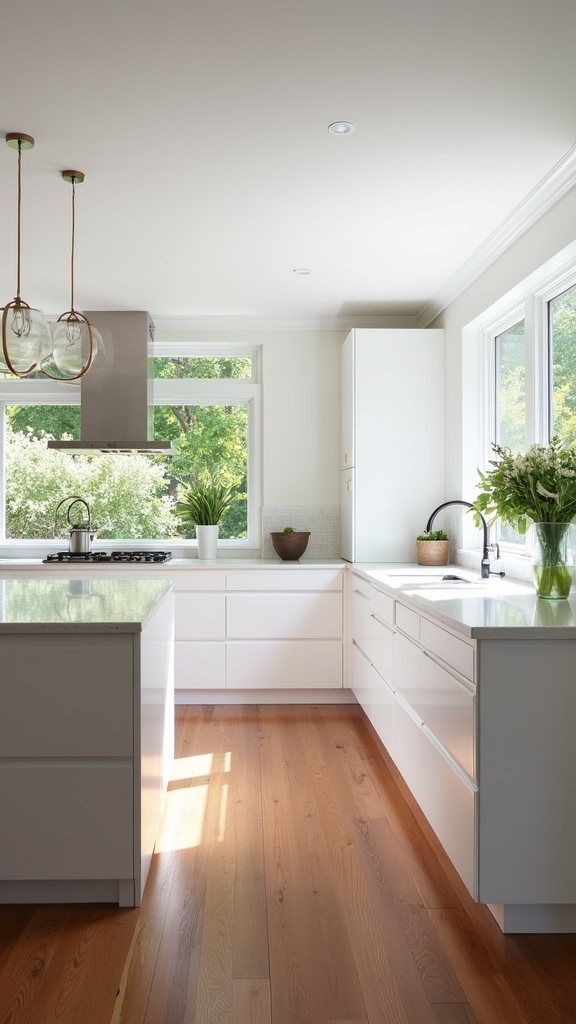
While prioritizing both aesthetics and environmental responsibility, selecting sustainable materials for kitchen cabinetry and flooring integrates eco-conscious principles into design.
Sustainable cabinetry and flooring choices not only reduce environmental impact but also improve indoor air quality and long-term durability.
Designers and homeowners can enhance a white kitchen with dark floors by implementing the following sustainable strategies:
- Material Selection: Use bamboo or reclaimed wood for sustainable cabinetry, providing strength and renewability.
- Low-VOC Finishes: Opt for low-volatile organic compound paints and sealants to mitigate indoor air pollution.
- Eco-Friendly Flooring: Choose luxury vinyl planks manufactured from recycled content or sustainably sourced hardwoods to guarantee responsible harvesting.
- Certifications: Confirm cabinetry and flooring choices are certified by organizations like the Forest Stewardship Council (FSC) for ethical sourcing and production.
This approach fosters a visually refined, environmentally responsible kitchen.
Personal Touches: Bringing Character to a Classic Palette
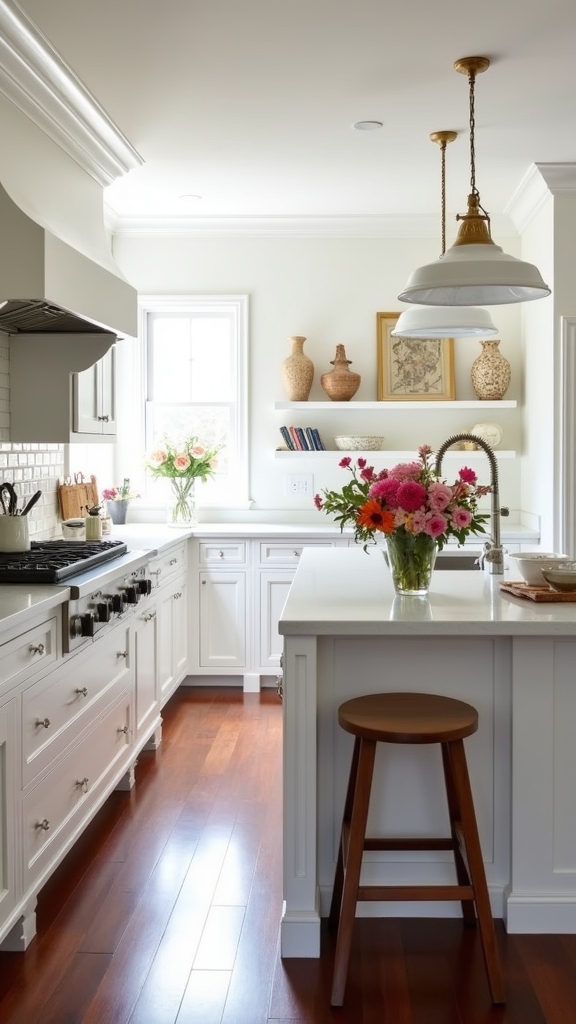
Integrating personal touches into a white kitchen with dark floors relies on deliberate design interventions that emphasize contrast, materiality, and curated detail.
Unique backsplash tiles, particularly those featuring multi-toned grays and off-whites, introduce nuanced visual interest and disrupt the uniformity of the classic palette.
The inclusion of natural elements, such as small succulent plants, injects organic vibrancy and softens the stark interplay between cabinetry and flooring.
Distinctive hardware selections—copper or matte black fixtures—function as sculptural focal points, contributing both tactile and visual differentiation.
Open shelving provides a platform to display artisanal dishware, further personalizing the space through curated objects.
Layering textures, for instance pairing sleek cabinetry with rustic wood accents, establishes depth and warmth, ensuring the kitchen maintains both refinement and individuality.
Frequently Asked Questions
What Color Kitchen Goes Best With Dark Floors?
When selecting ideal color combinations for kitchens with dark floor textures, designers often recommend crisp whites, soft grays, or muted pastels. These hues enhance spatial contrast, emphasize visual clarity, and adhere to balance and harmony in interior design principles.
How to Make a White Kitchen Less Clinical?
To diminish a clinical appearance in a white kitchen, designers introduce cozy accents and warm textures through natural materials, layered lighting, and strategic color pops, applying visual hierarchy and material contrast to achieve inviting, multisensory spatial harmony.
Should You Have Dark or Light Floors With White Cabinets?
Selecting dark floors with white cabinets leverages dark floor benefits such as visual grounding, durability, and effective concealment of wear, while the light cabinet contrast amplifies spatial perception, creates visual tension, and adheres to contemporary design principles emphasizing contrast and depth.
Should Kitchen Floor Be Lighter or Darker?
The ideal kitchen floor color—lighter or darker—depends on floor color psychology and current kitchen design trends. Lighter hues enhance perceived space and luminosity; darker tones offer visual depth and sophistication, aligning with contemporary design principles and functional priorities.
Conclusion
White kitchens with dark floors exemplify the dynamic interplay of contrast and cohesion, utilizing visual weight and luminosity to define spatial hierarchy. Through careful calibration of materials, lighting, and finishing details, this palette achieves both drama and refinement. Sustainable material selections and precise maintenance protocols further support enduring functionality. By integrating personal accents within a timeless framework, homeowners can craft kitchens that are not only visually striking but also ergonomically optimized and contextually resonant.
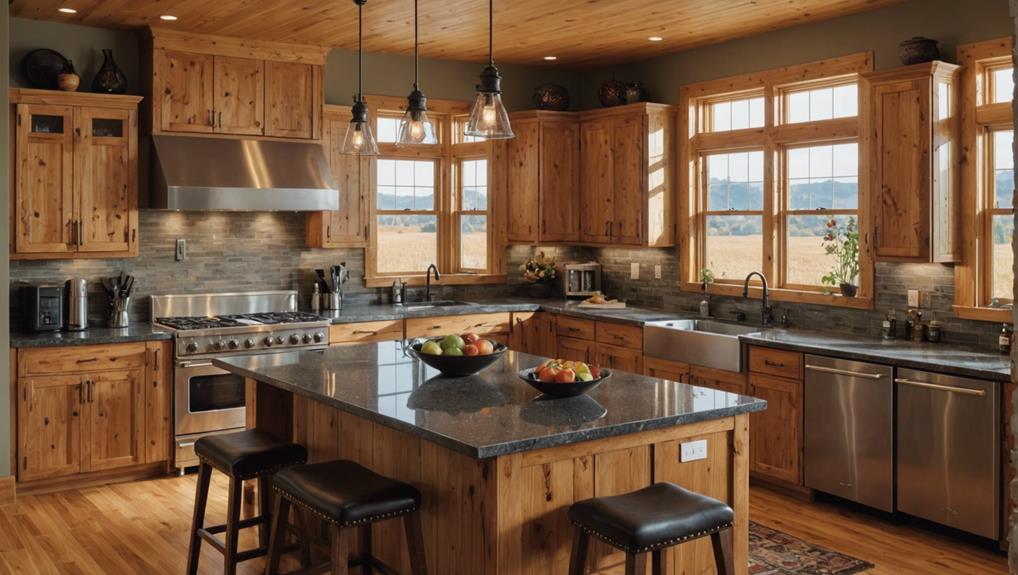
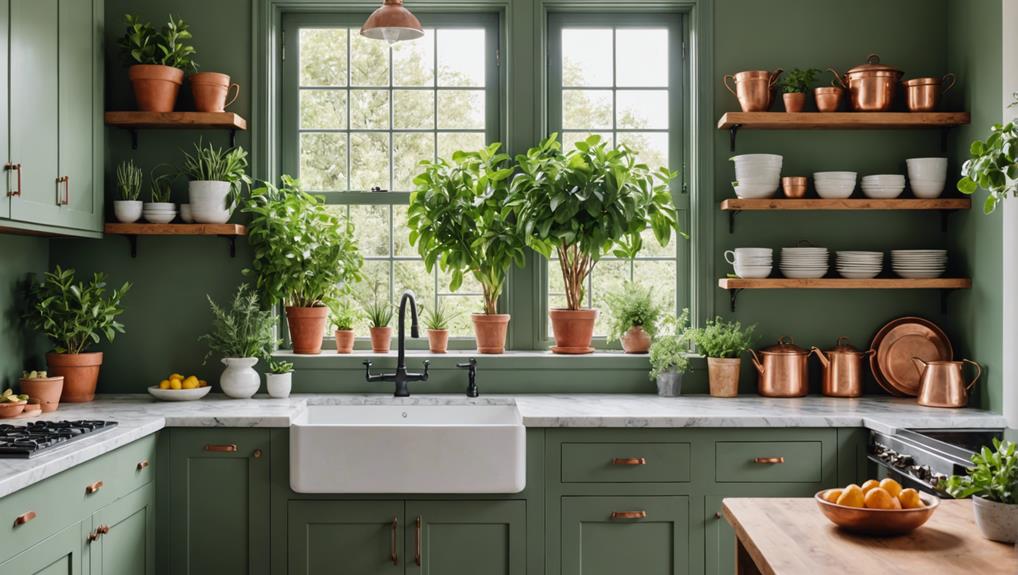
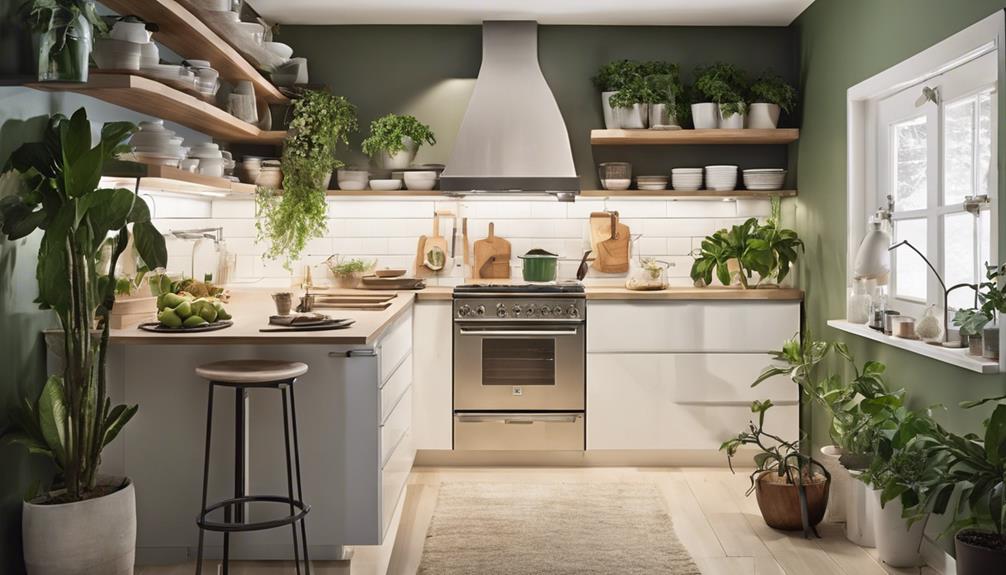
Leave a Reply